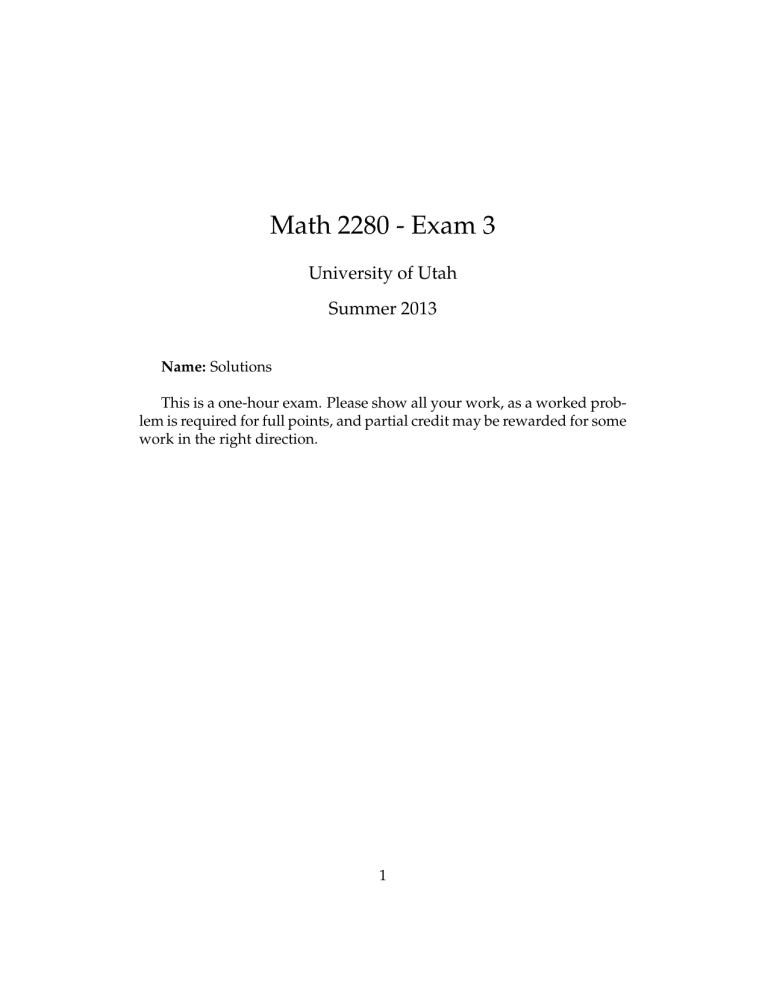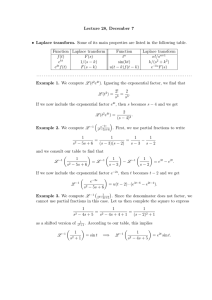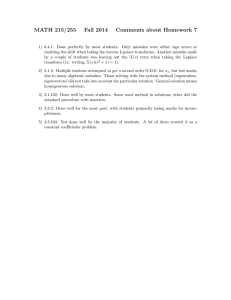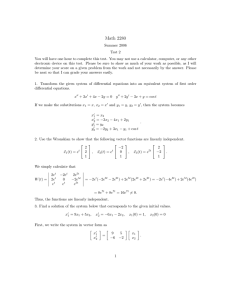Math 2280 - Exam 3 University of Utah Summer 2013
advertisement

Math 2280 - Exam 3 University of Utah Summer 2013 Name: Solutions This is a one-hour exam. Please show all your work, as a worked problem is required for full points, and partial credit may be rewarded for some work in the right direction. 1 Things You Might Want to Know Definitions Z ∞ L(f (t)) = e−st f (t)dt. 0 f (t) ∗ g(t) = Z t f (τ )g(t − τ )dτ . 0 Laplace Transforms L(tn ) = n! sn+1 1 s−a k L(sin (kt)) = 2 s + k2 s L(cos (kt)) = 2 s + k2 L(eat ) = L(δ(t − a)) = e−as L(u(t − a)f (t − a)) = e−as F (s). Translation Formula L(eat f (t)) = F (s − a). Derivative Formula L(x(n) ) = sn X(s) − sn−1 x(0) − sn−2 x′ (0) − · · · − sx(n−2) (0) − x(n−1) (0). 2 1. (20 points) Multiple Eigenvalues Find a general solution to the system of differential equations described by: ′ x = 7 1 −4 3 x. Solution - The eigenvalues for the coefficient matrix are: 7−λ 1 −4 3 − λ = (7 − λ)(3 − λ) + 4 = λ2 − 10λ + 25 = (λ − 5)2 . So, λ = 5 is the only eigenvalue, and it’s repeated. An eigenvector for this eigenvalue must satisfy: 2 1 −4 −2 v= 0 0 . 1 The vector works, and there is no other linearly independent −2 eigenvector. So, we want to find a chain of generalized eigenvectors. To do this we note: 2 1 −4 −2 2 = 0 0 0 0 . So, any vector that is not an eigenvector will work for the top vector 1 in our chain. If we choose v2 = we get: 0 3 v1 = 2 1 −4 −2 1 0 = 2 −4 . So, our general solution will be: x(t) = c1 2 −4 5t e + c2 4 2 −4 t+ 1 0 e5t . 2. Fundamental Matrices and Matrix Exponentials For the initial value problem 2 −1 x = x, −4 2 2 x(0) = , −1 ′ calculate: (a) (10 points) A fundamental matrix Φ(t) for the system. (Problem continued on next page.) Solution - To calculate a fundamental matrix we’ll want to find two linearly independent solutions, and to find two linearly independent solutions we’ll need to figure out the eigenvalues of the coefficient matrix: 2 − λ −1 −4 2 − λ = (2 − λ)2 − 4 = λ2 − 4λ = λ(λ − 4). So, the eigenvalues are λ = 0, 4. For the eigenvalue λ = 0 the eigenvector must satisfy The vector 1 2 2 −1 −4 2 v= 0 0 . works. For the eigenvalue λ = 4 the eigenvector must satisfy −2 −1 −4 −2 5 v= 0 0 . The vector 1 −2 works. So, two linearly independent solutions will be 1 2 0t e , 1 −2 and a fundamental matrix is: Φ(t) = 1 e4t 2 −2e4t . (b) (10 points) The matrix exponential eAt for the coefficient matrix 2 −1 . (Problem continued on next page.) A= −4 2 Solution - Using the fundamental matrix Φ(t) we calculated in part (a), we find: Φ(0) = 1 1 2 −2 , and −1 Φ(0) 1 =− 4 −2 −1 −2 1 = 1 2 1 2 1 4 − 14 . So, the matrix exponential eAt will be: At e −1 = Φ(t)Φ(0) = = 1 2 1 e4t 2 −2e4t + 12 e4t 1 − e4t 6 1 4 1 2 − 41 e4t + 21 e4t . 1 2 1 2 1 4 − 14 e4t , (c) (10 points) The solution to the initial value problem 2 −1 x = x, −4 2 2 x(0) = , −1 ′ Solution - Using the matrix exponential calculated in part (b) we get: At x(t) = e x0 = 1 2 + 21 e4t 1 − e4t 1 4 1 2 7 − 41 e4t + 12 e4t 2 −1 = 3 4 3 2 + 45 e4t − 52 e4t . 3. (10 points) Laplace Transforms Using the definition of the Laplace transform, calculate the Laplace transform of the function: f (t) = tet . Hint - Integration by parts may be useful. Solution - Using the definition of the Laplace transform (and some integration by parts) we get: t L(te ) = Z ∞ −st e Z t te dt = 0 te(1−s)t = 1−s ∞ te(1−s)t dt 0 ∞ 0 1 + s−1 e(1−s)t =− (s − 1)2 ∞ = 0 Z ∞ e(1−s)t dt 0 1 . (s − 1)2 Here the integral diverges if s ≤ 1, so the domain is s > 1. 8 4. (20 points) Laplace Transforms and Initial Value Problems Using Laplace transform methods, find the solution to the initial value problem: x′′ − 6x′ + 8x = 2; x(0) = x′ (0) = 0. Solution - If we take the Laplace transforms of the two sides we get: (s2 − 6s + 8)X(s) = ⇒ X(s) = 2 s 2 . s(s − 4)(s − 2) Taking a partial fraction decomposition of this rational function we get: 2 A B C = + + s(s − 4)(s − 2) s s−4 s−2 = A(s − 4)(s − 2) + Bs(s − 2) + Cs(s − 4) s(s − 4)(s − 2) (A + B + C)s2 + (−6A − 2B − 4C)s + 8A . = s(s − 4)(s − 2) 1 1 1 Solving for the unknown coefficients we get A = , B = , C = − . 4 4 2 So, our rational function becomes: 1 4 1 1 1 1 1 + − . s 4 s−4 2 s−2 9 The inverse Laplace transform of this funciton is: x(t) = 1 1 4t 1 2t + e − e . 4 4 2 This is the solution to our initial value problem. 10 5. (20 points) Solving a System of First-Order Equations Find a general solution to the system of first-order equations: x′1 = x1 + 2x2 + 2x3 x′2 = 2x1 + 7x2 + x3 x′3 = 2x1 + x2 + 7x3 Solution - The eigenvalues of the coefficient matrix are: 1−λ 2 2 2 7−λ 1 2 1 7−λ = (1 − λ)(7 − λ)2 + 4 + 4 − (1 − λ) − 4(7 − λ) − 4(7 − λ) = −λ(λ − 9)(λ − 6). So, the eigenvalues for this matrix are λ = 0, 6, 9. For the eigenvalue λ = 0 an eigenvector must satisfy: 1 2 2 0 2 7 1 v = 0 . 2 1 7 0 4 The vector −1 works. −1 For the eigenvalue λ = 6 an eigenvector must satisfy: −5 2 2 0 2 1 1 v = 0 . 2 1 1 0 11 0 The vector 1 works. −1 For the eigenvalue λ = 9 an eigenvector must satisfy: −8 2 2 0 2 −2 1 v = 0 . 2 1 −2 0 1 The vector 2 works. 2 So, the general solution to this system of ODEs is: 1 4 0 6t e + c3 2 e9t . + c2 1 x(t) = c1 −1 2 −1 −1 12






